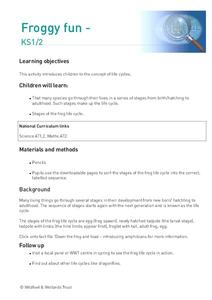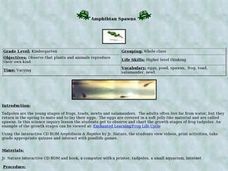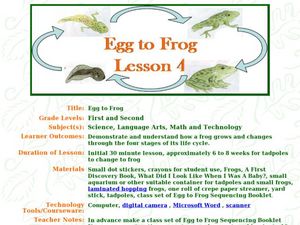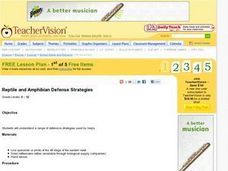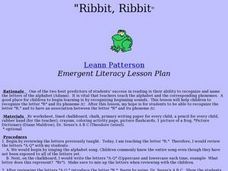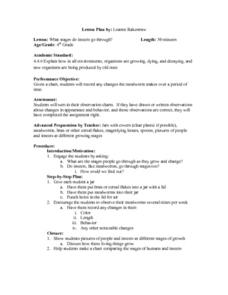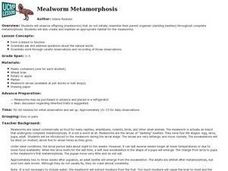Purdue University
Reptiles, Amphibians, and the Scientific Method
What do a reptile and an amphibian have in common? A three-part lesson allows scholars to investigate the similarities and differences between the two types of animals by identifying specific body parts. The lesson highlights the...
Curated OER
Life Cycle of a Salamander
Third graders examine the life cycle of a salamander. For this life cycles lesson, 3rd graders view a PowerPoint presentation about the life cycle of a salamander. Students take the temperature of a toy salamander with a thermometer and...
Curated OER
A Frog's Life Story
Students investigate the lives of frogs by completing several worksheets. In this biology lesson, students discover the life cycle of a frog from tadpole to death. Students complete frog life cycle puzzle as well as create a life cycle...
Curated OER
Froggy Fun
Students are introduced to the concept of life cycles. They discover how many species go through their lives in a series of stages from birth or hatching to adulthood. Such stages make up the life cycle. Students investigate the life...
Curated OER
Reptiles and Amphibians
Introduce your class to various reptiles and amphibians. They will meet and identify a representative from each of the four major reptile families, then learn about and discuss reptile characteristics. Next, they will identify and...
Curated OER
Pond Ecology
A lab activity is a great way to incite thoughtful questioning and scientific processes. Pupils will collect organisms with a Petri dish, make observations, sketch the organism, ask questions, then attempt to identify the specimen...
Curated OER
Amphibian Spawns
Students observe tadpoles as they gradually change into adults. In this amphibian biology lesson, students watch tadpoles in a tank in the classroom, keep a daily record of what they observe, and chart the growth development of the...
Curated OER
Egg to Frog
Students study the life cycle of the frog. In this life cycle lesson set, students listen to a read aloud of Frogs, A First Discovery Book, and make a sequencing booklet that shows the four stages of the frogs life cycle. They observe...
Curated OER
Coqui Frog Populations
Pupils research Coqui frogs. Students explore the life cycle of coqui frogs and discover how these frogs have become an invasive species in Hawaii.
Curated OER
Reptile and Amphibian Defense Strategies
Students study the stages of the Eastern newt either by collecting a live specimen or from pictures. They note the colors of the eft stage before reading the "Eastern Newt Species Account" that shows the newt's life stages, migration,...
Curated OER
Ribbit! Ribbit!
Pupils research a frog's life cycle and habitat using books, the Internet and lecture. Students make origami frogs, write letters to Toad from Arnold Lobel's "Frog and Toad" and participate in a simulated camouflage activity.
Curated OER
The Froggy Page
Learners investigate the cycle of life by observing tadpoles. In this biology lesson, students utilize the Internet to read stories, observe pictures, and listen to sounds of frogs. Learners create a poster board collage using frog...
Curated OER
What Stages Do Insects Go Through?
Fourth graders observe mealworms over a period of time and record any changes they observe. They record any changes in color, length, behavior, and any other noticeable changes, identify the stages of the mealworms, and create a chart...
Curated OER
Biodiversity in Illinois-Pond Habitats
Second graders construct a pond habitat in the classroom using a small swimming pool partially filled with water, real cattails, a tree log adjoining, and plastic animal life appropriate to a pond setting. They examine the frog in detail...
Curated OER
Migration Woes
Learners are able to describe the reproductive cycle of the gopher frog. They are able to describe the impacts of habitat loss and degradtion on gopher frog populations. Students are explained that many factors limit the survival of...
Curated OER
Creating a Food Web
Young scholars investigate hunters and prey by creating a food web. In this animal life lesson, students investigate a single organism in preparation for a field trip, discovering its diet and habitat. Young scholars each discuss their...
Curated OER
Mealworm Metamorphosis
Students observe offspring (mealworms) that do not initially resemble their parent organism (darkling beetles) throughout complete metamorphosis. They also create and maintain an appropriate habitat for the mealworms.
Curated OER
Development in Drosophila melanogaster
Pupils study the least familiar aspect of development in Drosophila melanogaster; the development of the pupa. Students isolate and culture "First-day" pupae. They are dissected daily to study the progressive developmental changes.
Curated OER
The Lepidoptera Project
Young scholars are introduced to Scientific Inquiry and discover how to design an experiment that answers critical questions using butterflies as the topic. They design experiments that compare the number of species of butterflies in a...





